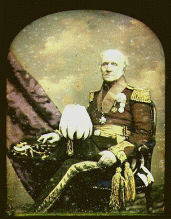Henry Goldfinch


Lt-General Sir Henry Goldfinch KCB (24 November 1781[1] – 21 November 1854) was an officer in the Royal Engineers who served during the Peninsular War of 1807 to 1814, ending his career as one of the colonels commandant of the Corps of Royal Engineers.[2] He was appointed a Companion of the Order of the Bath (CB) in 1815[3] and a Knight Commander of the Order of the Bath (KCB) in 1852.[4]
Harry Goldfinch was born in London, the son of Henry Goldfinch and his wife, Ann Paterson or Patterson.[5] He was educated at Tonbridge School and the Royal Military Academy, Woolwich.[6]
He joined the army in 1796 as an officer in the Royal Engineers and served at Hanover (1805) and at the Battle of Copenhagen (1807).[7] He served with distinction during the Peninsular War from May 1809 to April 1814[7] and was present at the battles of Talavera (1809), Bussaco (1810), Vittoria (1813), Pyrenees (1813), Nive (1813), Orthez (1814) and Toulouse (1814).[8] He was captured at the Battle of Porto (1809) but managed to escape.[9]
Goldfinch was promoted to second lieutenant (1798), first lieutenant (1800), second captain (1805), captain (1807), brevet major (1812), brevet lieutenant-colonel (1813), lieutenant-colonel (1814), colonel (1837), major-general (1841), lieutenant-general (1851)[10][11] and colonel commandant (1854).[12] He received the Gold Cross for Vittoria, Nive, Orthez and Toulouse and the Military General Service Medal with three clasps for Talavera, Busaco, and the Pyrenees.[13]
With his wife, Catherine Elizabeth (née Thomas), he had two sons, Henry Robert Goldfinch[14] and John Howard Goldfinch, as well as two daughters, Mary Louisa Goldfinch and Catherine Elizabeth Goldfinch.[15]
He died at his home at 11 Upper Wimpole Street, London, on 21 November 1854, aged 73, and was buried at Brookwood Cemetery on 25 November 1854, just two weeks after the cemetery opened, being the 29th person to be buried there. His is the oldest surviving memorial anywhere within the cemetery.[8][16][17]
References[edit]
- ^ England, Select Births and Christenings, 1538–1975
- ^ Appointment of Colonels Commandant – The London Gazette 17 February 1854 p468
- ^ Appointment to Companion of the Order of the Bath – The London Gazette 16 September 1815 – Google Books p1880
- ^ Appointment to KCB – London Gazette 5 April 1852 p988
- ^ England & Wales, Non-Conformist and Non-Parochial Registers, 1567–1970
- ^ "Obituary: Lieut.-Gen. Sir Henry Goldfinch". The Gentleman's Magazine and Historical Review. Bradbury, Evans. February 1855: 190. Retrieved 13 May 2019.
{{cite journal}}: Cite journal requires|journal=(help) - ^ a b Henry Goldfinch – The Napoleon Series
- ^ a b Lieut.-Genl. Sir Henry Goldfinch KCB on John Clarke's Brookwood Cemetery website
- ^ Dr. Mark S. Thomson, Wellington's Engineers: Military Engineering on the Peninsular War 1808–1814, Pen & Sword Military (2015) – Google Books p42
- ^ John Philippart, The Royal Military Calendar, Or Army Service and Commission Book Volume 4, London (1820) – Google Books p495-496
- ^ Death of Lt. Ge. Henry Goldfinch – The London Gazette 9 January 1855 p86
- ^ John Clarke, An Introduction to Brookwood Cemetery, Necropolis Publications (1992) p10
- ^ Goldfinch -War Services of the Officers of the Royal Engineers – Hart's Army List
- ^ Edward Walford, The County Families of the United Kingdom, Robert Hardwicke, London (1860) – Henry Robert Goldfinch – Google Books p255
- ^ Marriage of Catherine Elizabeth Goldfinch – 26 February 1853 – The Spectator p19
- ^ Lt-General Sir Henry Goldfinch on the Brookwood Cemetery website
- ^ 'Brookwood – the largest cemetery in Britain' – BBC News – 27 August 2010
External links[edit]
- 1781 births
- 1854 deaths
- Royal Engineers officers
- People educated at Tonbridge School
- Graduates of the Royal Military Academy, Woolwich
- Burials at Brookwood Cemetery
- British Army personnel of the Peninsular War
- British Army personnel of the French Revolutionary Wars
- British Army personnel of the Napoleonic Wars
- Recipients of the Army Gold Cross
- Companions of the Order of the Bath
- Knights Commander of the Order of the Bath
